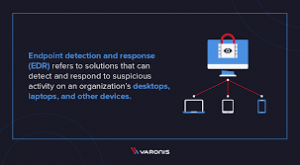If you wonder who EDR is suitable for, well to talk about EDR, Endpoint detection & response, sometimes referred to as endpoint detection and threat response (EDTR), is an endpoint security system that constantly keeps track of end-user devices for cyber security threats such as ransomware and malware.
According to Anton Chuvakin of Gartner, EDR is referred to as a program that monitors and stores endpoint-system-level behaviors, provides contextual information, blocks suspicious activities, implements an array of data analytics techniques to identify malicious system behavior, and offers remediation suggestions to restore infected systems. So let’s talk about who EDR is good for.

Why is EDR Security Important?
An EDR security solution keeps track of all endpoints linked to the business network, identifies risks, and executes potential responses. Here are some of the advantages of using EDR technology to understand who EDR is good for:
Constant endpoint visibility: EDR systems continuously monitor and seek threats. This data can be used to prevent threats and assess past and ongoing attacks. Several operations can be automated to keep your staff working while retaining visibility at all times.
Detection of unknown threats: Conventional antivirus and firewalls are designed to detect known threats, which are often detected via signature-based detection. An EDR system can actively detect unknown threats and assist you in blocking and preventing advanced attacks. Generally, this is achieved by using artificial intelligence-powered behavior analysis skills (AI).
Quick incident response: When the EDR solution identifies a security event, it immediately begins containing the threat. The solution isolates any affected endpoints and responds swiftly to the incident. Meanwhile, the security administrator or team receives notifications and can respond swiftly. To prevent an event from escalating, an early automated response is crucial.
Effective cyber forensics: To discuss who EDR is suitable for, EDR tools include forensic features such as visualizations. The solution collects data and generates reports on each step of the killing chain in real time.
Top reasons you need EDR – who EDR is good for?
Endpoint Detection and Response (EDR) products are designed to improve endpoint security by enhancing detection, investigation, and response capabilities. These are a few reasons why EDR should be included in the endpoint security plan and who EDR is good for.
Adversaries can stay in the network for weeks at a time.
They may also return anytime: Silent failure will only allow attackers in your surroundings to move freely. They could build back doors that allow them to return whenever they choose. Only a third party, such as your suppliers, customers, or law enforcement, can identify the breach.
Prevention alone will not provide complete protection.
Because of the existing endpoint security solution, your firm will likely remain in the dark. The attackers will take full advantage of this and easily roam the network.
To respond to such incidents, access to relevant and actionable intelligence will be required. To talk about who EDR is good for, aside from a lack of visibility, organizations may need to be made aware of what is happening on their endpoints. They may be unable to record security-related events, store, and then retrieve this vital information as and when required.
Companies lack the visibility required to monitor endpoints adequately.
If a breach is identified, you will most likely spend a significant amount of time determining what exactly led to the incident, what exactly took place, and how it is to be addressed. This is due to a need for more visibility. Yet, the attacker will only return in a few days before proper corrective action is done.
Data is a part of the solution.
Even if data is available, security teams will need sufficient resources to examine and fully benefit from it. As a result, security teams have become aware that even after adopting event collection tools such as the SIEM, they frequently encounter complex data issues. Different issues and challenges arise, such as what to identify, scalability, and speed before addressing the significant objectives.
Conclusion – who EDR is good for?
Now you know who EDR is good for. Over the last few years, the EDR market has expanded at a rapid pace. Hackers now have easy access to increasingly complex and sophisticated technologies. Without question, cyberattacks are becoming increasingly common.
The truth is that cyberattacks on endpoints are becoming increasingly complicated and widespread. As digitalization continues to revolutionize governments, industries, and enterprises, massive numbers of devices are likely to be accessible online. And only forty million traditional endpoints out of 700+ million are estimated to have implemented EDR solutions at the moment.
Open EDR combines analytic detection with Mitre ATT&CK visibility to deliver real-time event correlation and root cause analysis of hostile threat activity and behaviors. To fight against threat actors and hackers, this world-class endpoint telemetry technology is available to all cyber-security professionals and organizations of every size. Visit for more.
See Also:
EDR Explained
FAQ Section